Pauline Wambui, online entrepreneur
Every day Pauline Wambui Mbugua would sell her bananas at a roadside stall, earning just enough to put food on the table.
Then she joined Hand in Hand’s accelerator programme and learned how to use What’s App for business. Immediately, Pauline posted every item of produce she had and that, says Pauline is, “when things started to get better”. Her first online sale of bananas went for KSH 12,000 (US $82), avocadoes now sell for up to KSH 120 (US $0.82) per kilo, almost four times what she could earn at the market, and she now sells the macadamia nuts directly the Kenya Nut Company.
Pauline says, “I didn’t get to complete my high school education…[but] joining Hand in Hand really helped me… [they] helped me plan my farm…and now I know selling online is better as compared to local sales.”
‘People can’t go to the market. But I can bring the market to them’: Bathsheba
Ask a resident of Kitui County, Kenya what scares them most about the coronavirus. Some will say illness. Others will say joblessness. But just as often as not, you’ll get a third answer: hunger. With markets shuttered, transportation halted and strict curfews imposed countrywide, in some counties the greatest threat isn’t the virus but a simple scarcity of food.
Enter Bathsheba Kilonzi, smallholder farmer, Hand in Hand member, and answer to many of her neighbours’ prayers.
Konza Village, Machakos County
Kenya’s lockdown: empty markets, bare cupboards
Kenya’s health system isn’t equipped to cope with Covid-19. Prevention, not treatment, is the country’s only hope. That was the government’s thinking in early-March, when it imposed sweeping lockdown measures that banned large gatherings, effectively shutting down markets countrywide. To be certain, these measures have helped halt the spread of the virus. But in a country where 85 percent of food goes through outdoor, informal markets, the policy has come at a precipitous cost.
With access to tens of thousands of smallholder farmers in dozens of counties countrywide, Hand in Hand is doing everything we can to help. Since the start of the lockdown, our trainers have instructed almost 15,000 members by phone and SMS on finding new sources of seedlings and crops where necessary, then making sure their produce finds buyers. Aside from helping to prevent tens of thousands of Kenyans from going hungry, it’s keeping thousands of smallholder farmers from going under.
Finding opportunity
 Before coronavirus, Bathsheba was a smallholder farmer growing spinach, kale, onions, carrots and pawpaw, a cousin of papaya. Every week, she would travel to her local market in Konza village and set up a stall. “When the lockdown came, people couldn’t go to the market. But after I spoke to Hand in Hand I realised that I could bring the market to them,” she says.
Before coronavirus, Bathsheba was a smallholder farmer growing spinach, kale, onions, carrots and pawpaw, a cousin of papaya. Every week, she would travel to her local market in Konza village and set up a stall. “When the lockdown came, people couldn’t go to the market. But after I spoke to Hand in Hand I realised that I could bring the market to them,” she says.
One sweltering morning in early-March, Bathsheba strapped on a facemask, packed a basket and set out selling her vegetables door-to-door. Demand, she discovered, was huge. With the help of her Hand in Hand Self-Help Group, she identified other smallholders with produce to offload, and has since become her village’s biggest distributor. “I follow all the precautionary messages such as wearing a face mask while delivering my supplies,” she says.
Today, Bathsheba’s monthly income has doubled, reaching 10,000 KES (US $100) a month. Not only are her husband and three children financially secure during this incredibly uncertain time, but she’s never felt prouder.
“I feel good being part of the team that is playing a role in curbing the spread of coronavirus by helping people access food as they stay at home,” she says.
By the numbers
Income before outbreak: 5,000 KES (US $50) a month
Income now: 10,000 KES (US $100) a month
Farmers reached via phone with support and advice: 15,000
‘In order to survive we were forced to be creative’: Rhoda
Upcycling factory offcuts and old tyres to make handbags and sandals. That was the Uwezo Wema Self-Help Group’s business model, and for two years, it worked. Then came the coronavirus and, according to group chairperson Rhoda, “everything changed”.
“Business performance has gone down, and the usual products we used to sell during the pre-corona period are no longer in high demand due to change in people’s expenditure,” she explains. “In order to survive we were forced to be creative.”
If demand for sandals and bags had cratered, for two others items it had gone through the roof. So it was that Rhoda and her Uwezo Wema sisters started making and selling face masks and soap, finding themselves front and centre in their community’s response to Covid-19.
Babadogo, Nairobi
A world in turmoil. A country in lockdown
Taking rare a break from her sewing machine recently, Rhoda spoke to her Hand in Hand trainer over the phone. Visiting, she agrees, would be out of the question. Just days after its first confirmed case in early-March, the government of Kenya imposed a strict and wide-ranging lockdown on this country of 51 million, fearing its health system couldn’t cope. Inter-county travel was banned and a 7 pm to 5 am curfew was imposed, but millions of Kenyans who had to work to survive, did. The result, say officials, is a country where “the virus is firmly in our midst.”
To the extent that Kenya weathers the storm, it will because of people like Rhoda and the Uwezo Wema Self-Help Group leading the grassroots response. “The government is not able to fight this disease alone,” she says. “The largest responsibility lies with individual citizens to ensure they wash their hands, sanitise, wear masks and maintain social distance. My job as a businesswoman is to help them do that.”
With access to tens of thousands of members in dozens of counties countrywide, Hand in Hand’s job as an NGO is to help businesswomen like Rhoda lead the way. In only a month, our trainers have reached more than 11,000 members over the phone to provide advice on retooling their businesses to make face masks and soap. Aside from empowering tens of thousands of Kenyans to fight the spread of the virus, we’re keeping thousands of businesses from going under.
‘We are thankful’
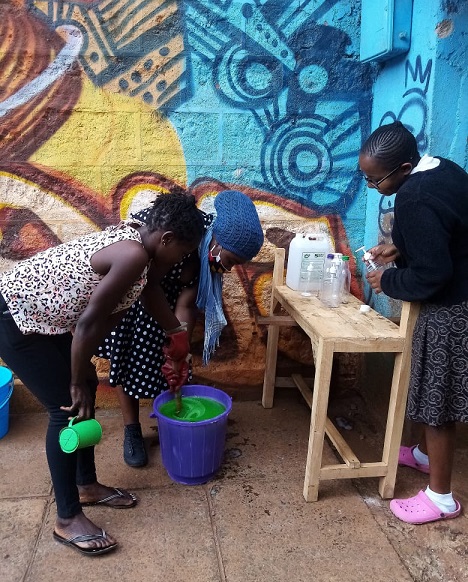
Uwezo Wema group members make soap from alcohol, aloe vera and lemon.
Rhoda, it turned out, had beaten us to the punch. “After the government announced the precaution measures to be put in place like washing of hands with soap and disinfecting our hands and wearing masks, we decided to focus on the production of masks and sanitisers. This is because there was no big competition as in the liquid soap making,” she says.
The transition from bags to masks was straightforward enough, says Rhoda, who quickly developed a prototype after watching instructional videos online. For the most part, the group is still using upcycled cloth offcuts – keeping their business environmentally sustainable even as they contribute to the greatest public health push in Kenya’s history. Filters between the masks’ two layers and heavier cotton to keep them durable have marginally increased costs. As for making soap, Rhoda remembered a recipe from one of her Hand in Hand training modules using alcohol, aloe vera and lemon.
“We currently sell about 200 masks and anywhere from 15 to 50 litres of soap a day,” she says. It’s enough to bring in about 20,000 KES (US $200) a month – a far cry from the 100,000 KES (US $1,000) her group made each month before the virus, says Rhoda, but “we are thankful that at least we can make something during such a time.”
For those lacking the luck – and savvy – of the Uwezo Wema Self-Help Group, Rhoda keeps back a number of masks each day to give away. “But not to everyone,” she says. “We need to earn some profit for sustainability.”
By the numbers
200 masks and 32.5 litres of soap sold each day
20,000 KES (US $200) a month in income
11,000 members reached with advice on making face masks and soap
‘Helping us help ourselves’: Josephat
Josephat Mwaniki Njeru had run his own business for nearly four years, but it was becoming clear he needed a little bit of help.
It didn’t matter that the organisation offering it, Hand in Hand International, included nearly 20 local women and not a single other man. In fact, he recognised the challenges women faced in finding jobs in Kenya’s Kirinyaga County, and he saw no downside in learning from their tenacity.
With aid and support from Hand in Hand’s Self-Help Group, Josephat has gotten the boost he needs. His shop, which sells sugar, rice and flour among several other goods, is no longer struggling. After one expansion, he already has eyes on making it even bigger.
“There would be no difference if it was just a men’s group,” Josephat said. “However, from what I see, these women have been involved in many more activities than men. Men don’t always like group formations, but right from when I was a child, I liked group activities. I like being involved in doing something.”
Kirinyaga County, Kenya
A Decision Made
From early on, Josephat was faced with two choices: he could go into farming, like the majority of residents, or he could open a business. That question was answered when he realised the land he owned was not going to help him provide for his family.
Small-scale farming is prevalent in the region and most farmers grow coffee, tea, rice and various fruits and vegetables. None of those crops, though, would help Josephat earn enough to provide for his wife, let alone four children or three grandchildren.
“I have three-quarters of an acre of land,” Josephat said. “That is not sufficient, so for me, I don’t have much option other than business. It’s the main thing — it’s where I eat from. I do everything from the business. I love my business.”
Taking A Risk
Josephat had only KES 1,700 (US $17) to his name when he decided to open his shop, and although he was able to obtain a loan for KES 15,000 (US $150), he had been struggling to pay it back. Whatever profits he earned went immediately into feeding his family.
That’s when he and three other men were introduced to Hand in Hand, which offered them the opportunity to learn from local trainers about responsible shopkeeping. Josephat loved what he heard and quickly bought in to a group of 19 women.
“Even if I am the only man in the group, I feel comfortable because we are doing things together and when we carry out activities, we do them together,” Josephat said.
Those activities included lessons on the principles of table banking, responsible inventory and financial management, all of which Josephat knew he needed. Soon, his income started to increase, allowing him to generate more than KES 7,000 (US $70) in profit a week.
The original loan has long been paid off, as has a second, and he’s trying to secure yet another in order to help his business continue to grow.
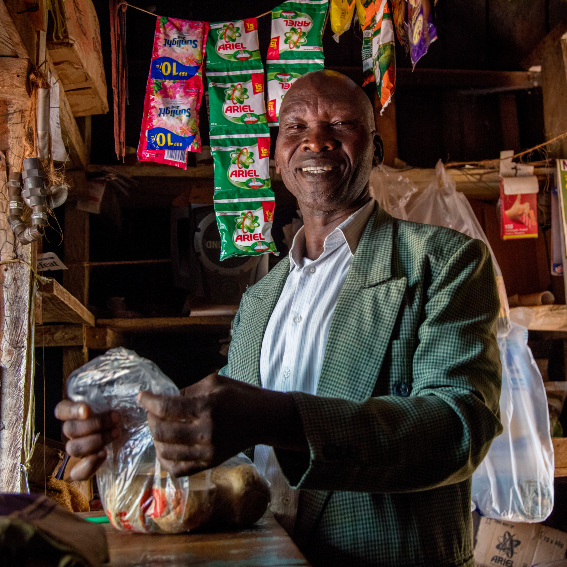
“Before I joined Hand in Hand, I did not know how to organise myself, but after we started to learn some lessons, I asked many questions,” Josephat said. “Where I don’t understand, I ask for help. Where my business is not doing well, I ask for help. I try to put in practice what the teacher had recommended, so I see my business has improved from what it was before.”
Paying It Off
Although Josephat takes care to reinvest much of his profits into his business, his family has benefitted greatly from his larger earnings. His four children, who range in age from 26 to 33, can live slightly more comfortably because Josephat wants to pay for his grandchildren’s school fees.
“What I can say? These donors, they really help,” Josephat said. “When people come together in groups, they benefit immensely. Isn’t that good? What we lack while in our homes is backing and ground for exposure to push us so that whatever economical activities one is involved can be boosted and grow so that one can depend on it sustainably.
“It will improve your life standard. I have said several times that funds are the main problem. We have a lot of duties: you want to eat, you have children at school, hospital bills and other things. So, what happens when you look back at your backyard and you see that you don’t have money? Donors are really helping us help ourselves.”
The group has also helped Josephat’s family in another way. His wife has begun working at a tree nursery that was also set up with the assistance of the Self-Help Group.
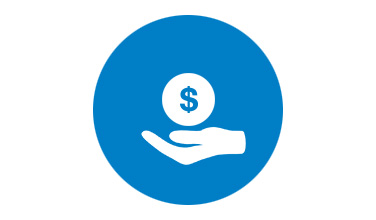
Finally repaid a loan that had long been outstanding
Learned how to do an inventory of his stock
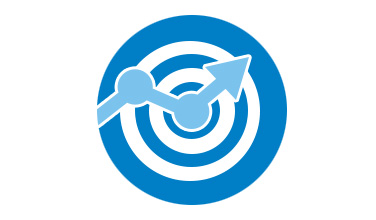
Developing plans to continue expanding business
‘I will be ending poverty’: Jamleck, a farmer transforming Kenya
Jamleck Laska Arume is hoping he holds the solution for the droughts that have affected millions of Kenyans.
A 28-year-old farmer whose family owns seven acres of land in Embu County, Jamleck has planted banana trees that agronomists believe will be less susceptible to climate shocks.
It’s an especially exciting proposition because the drought wiped out nearly his entire maize harvest last year. Now part of Hand in Hand’s push to help more than 40,000 farmers stand up to climate change, Jamleck had to shoulder the additional expense of pumping water to the farm.
Even then, he was left with barely enough maize, notoriously vulnerable to climate variability, to provide for his own family.
“We didn’t have anything,” he said. “Like, specifically, we used maize for what we use in the house. These bananas, we are using them as a business. We can use them to earn money.”
Embu County, Kenya
New crops, new future
Kenya’s National Drought Management Agency now believes that droughts will distress the region every five or so years. More than three quarters of the country has been affected by the most recent devastation, and even those counties that have recovered are still experiencing severe vegetation deficit. Livestock, and not just crops, has also been lost.
An estimated 14 million people in Kenya can’t meet daily food requirements, according to research from Kenya’s Egerton University, and 4 million couldn’t even meet their daily calorific requirements if they spent their entire incomes on food. Almost all of these people are rural.
Bananas are one of the most prevalent crops grown throughout Kenya, but, like maize, they’re also highly susceptible to diseases and moderate changes in climate. By adopting techniques and farming what are known as tissue culture bananas, which are more resistant, can produce higher yields and grow much faster, they can help mitigate drought-stricken areas like Embu County.
That’s why Jamleck has volunteered to plant them. Not only is his family’s farm large enough, he has never grown bananas — an important characteristic to making sure the tissue culture bananas thrive because the land will not have been previously affected by disease.
Hand in Hand, with the support of the IKEA Foundation, will continue to help Jamleck with growing the bananas on his “demo farm,” providing him with the tools and instruction he needs to make sure they succeed. Once they’re ready, he and others in the community will be brought together to negotiate with wholesalers to distribute the bananas around the country.
All told, Jamleck will be one of more than 43,000 smallholder farmers who will have increased their incomes while helping thousands of communities address issues they face directly as the result of climate change.
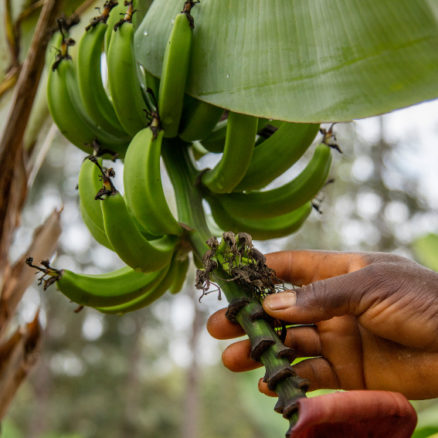
“I feel it’s just what I need,” Jamleck said. “What I have been learning in the community will be ending poverty, so what I need is to help others so they can also learn from me.”
A bright future
Jamleck’s interactions with Hand in Hand haven’t been limited to planting bananas. He has also learned a lot about the fundamentals of running a business, including the process of learning how to manage profit, and has begun to recognise there are ways he can increase his margins.
“They didn’t tell us they would give us anything, but they showed us,” he said. “They want to make us stand by ourselves. They want us to be able to do more things by ourselves so we can produce and we can accomplish more things.”
Thus far, Jamleck has been able to purchase his own water pump to help irrigate his crops, and he wants to buy additional cows to better fertilise the farm. His next step will be to hire people who can help him with the farm, not only to plant and harvest the crops but also to take the coffee beans to be sold and processed at local factories.
And, because he regrets that his parents were not able to pay for him to have a proper education, his ultimate goal is to make enough money to be able to do so for his 2-year-old daughter, Blessings.
Should the banana crop succeed, Jamleck will not only have provided her with a future but will have done so for countless of people across Kenya as well.
Planted resistant banana crop to mitigate drought effects
Purchased water pump with profit from existing maize and coffee crops
Developing plans to continue expanding business
‘I now feel good because I have money’: Roseline, chip vendor
Even though she recognised the importance of providing her children with an education, Roseline Ngeno hurt every time she had to pay their school fees. The salary her husband made as a teacher only went so far, and because the tuition was a priority, the family often struggled to meet basic needs.
That all changed once Roseline, 40, joined a Hand in Hand Self-Help Group generously supported by the IKEA Foundation. Empowered with the knowledge of how to run a business, she has been growing potatoes and selling chips that residents of her village of Molem, in the ward of Merigi in Kenya’s Bomet East sub-county, can’t stop eating.
“I now feel good because I have money,” Roseline says. “I have no worries. When my children want clothing, I have money. If I want to plant in the garden, I have money. I calculate my profits and I keep them and use them well.”
Bomet County, Kenya
A difficult path
Women living in Bomet county such as Roseline have a hard time finding permanent employment. As she says, “Women don’t have a chance of getting jobs here.”
The Kenya Red Cross Society determined in a 2015 study that 42.9 percent of households in Bomet County earn less than US $3.20 a day. Only 34 percent of women in the county aged 15-49 have at least some secondary school education, according to a 2014 report by Kenya’s National Bureau of Statistics.
Bomet is one of the most densely populated areas in western Kenya and, with 58,000 registered farmers, its economy leans heavily on agriculture. Even then, very few are women, as most tend to the home and the cattle, and almost none hold permanent jobs.
Chipping away boundaries
Roseline, who had occasionally earned a temporary income in the past, knew she needed to do something to help brighten the futures of her seven children. Through a friend, she heard about Hand in Hand’s Kondametutab Molem Self-Help Group in 2016 and joined, hoping to learn a thing or two about ways she could start her own business.
“I used to find it difficult asking my husband for money all the time, and when he said there is no money, I felt bad,” Roseline says. “But now, since I joined the group, I’ve been able to make money quickly.”
Having been taught the basics of bookkeeping, entrepreneurship and table banking, Roseline was able to access the land leased by the group. She then realised no one else was growing potatoes, and after thinking of a way to sell them to the rest of the community, she decided to turn them into chips.
Achieving that miraculous balance of crispy and unctuous, Roseline’s chips are a revelation – superior, 10 times out of 10, to the stodge at your local chippy.
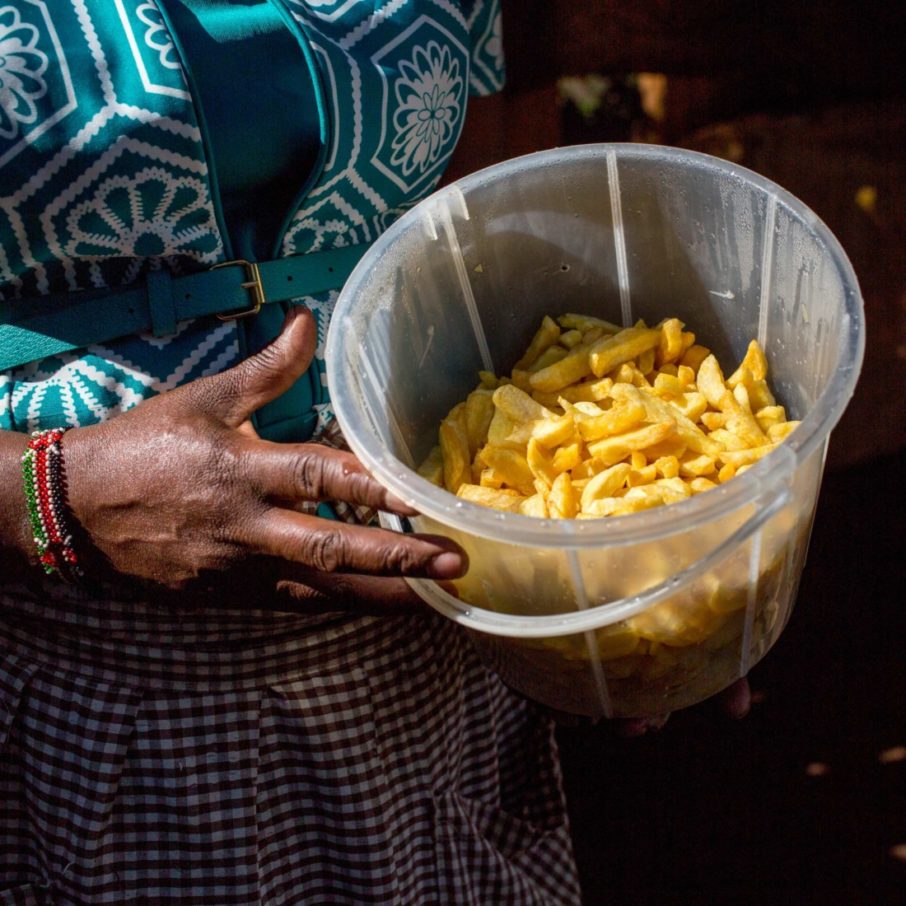
Roseline, who also sells tea and chapatis, offers the chips for KES 30 (US $0.30) or KES 50 (US $0.50), often to schoolchildren. While it helps that she doesn’t have any competition, finding the right recipe has kept villagers coming back for more.
“If you want to make good chips, you chop potatoes first, put the right amount of oil in the pot and cook them until they are dry — but not too dry,” Roseline says. “I prefer chips that are not very dry.”

Growing a future
Since starting her business, Roseline estimated she has been able to make KES 10,000 ($98 USD) a month. She has not only put that money toward her children’s school fees but has reinvested it as well.
“My income has increased very much,” she says. “The business does help me. I have been able to decorate my house and bought some utensils.”
Her goal is to expand the business, as she would like to one day be able to sell sugar and other food to people in the village. And her husband, whose time is limited because he teaches at a primary school far from home, has also helped out.
“I am thankful to God because the [Hand in Hand] donors have enabled me to join the Group that has taught me a lot of things,” Roseline says. “All this has improved my life.”
Roseline’s results
Learned fundamentals of shopkeeping
Able to provide for children’s school fees
Wants to continue to grow business
Meet Richard and Jane: the farmers transforming Kenya
“It’s not much to look at yet,” says Richard Langat, gesturing operatically at an empty dirt field, a twinkle of insane pride in his eyes. “But it will be.”
The 54-year-old farmer and Hand in Hand member has arrived at the edge of his smallholding, a quarter-acre of gently sloping countryside in Bomet County, Kenya, five hours west of Nairobi by SUV on roads so bumpy the four-wheel drive might as well have four legs. He’s been expounding on plants for the better part of an hour.
“All this one needs is a bit of pruning.” “Those? Those are soya beans.” “Insects, birds – they can’t resist capsicums [bell peppers]. That’s why I only grow a few: as a decoy to distract pests from my real crops.”
It’s an encyclopaedic display, one elevated to the miraculous by Richard’s apparent ability to forego breathing completely. But for all the activity on his buzzing farm, it’s this empty field, populated by a lone, straggly seedling not quite as tall as Richard’s old wellies, that’s caught the attention of neighbours and put Richard at the centre of not just his small rural community, but of Hand in Hand’s push to help more than 40,000 farmers stand up to climate change and move from subsistence to success. Far more notable than soya beans and decoy peppers is what’s not here: maize.
Bomet County, Kenya
Out with the old
If you’re in Kenya and you’re eating, you’re eating ugali. Made by boiling maize flour and, if you’ve got the money, enjoyed alongside meat or fish, this stodgy staple with a texture somewhere between polenta and drying cement is less the national dish than a central fact of existence. For millions of subsistence farmers, it’s the only meal they’ll eat all day.
Introduced by the Portuguese in the 17th and 18th centuries, then grown for export under British occupation in the 19th and 20th, the crop shot to ubiquity after colonial landowners discovered it also served a domestic purpose: cheap fuel for farm labourers. To consider the history of maize, in other words, is to consider the history of Kenya itself. But if maize has shaped the country’s past, it cannot shape its future, say experts. Famously vulnerable to ‘climate variability’ – droughts, floods, the vicissitudes of climate change – the crop is putting Kenya’s food security at risk, even while dooming millions of farmers like Richard to a cycle of deepening poverty.
“Since I’ve been here I’ve been trying to make money out of this farm, but I couldn’t,” he says. “When we invest KES 10,000 (US $100) in maize and come away with KES 3,000 (US $30) it’s not even enough to feed our family. We’re really making a big loss.”
For Richard, as for his neighbours, the solution is clear: stop growing maize and start growing something else. That’s easier said than done. Asking most Kenyans to stop growing maize is like asking a Kansan to stop growing wheat, or a shepherd in north Wales to abandon his flock.
Richard isn’t most Kenyans.
Beside every good man
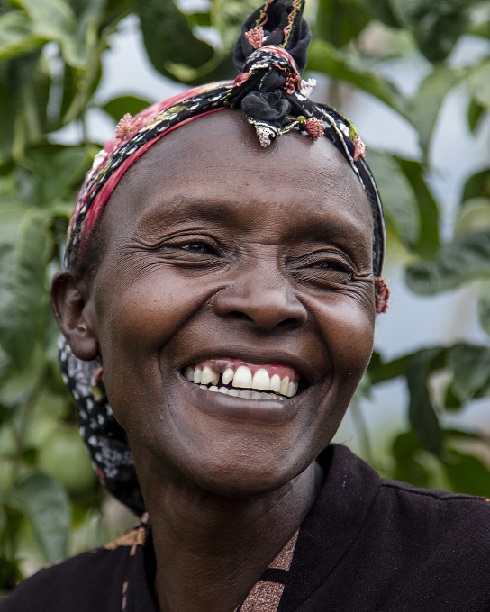
Jane, 47.
Richard met Jane at a funeral. It was love at first sight.
Twenty-six years later the married couple still finish each other’s sentences, still audibly thrum when the other comes near. Richard likes to talk politics. Jane prefers to talk church. But get them going on any of their five children or the farm they’ve built up over the years and the two sing in perfect harmony.
“Before I was given this farm by my parents, the land was really exhausted,” says Jane, 47. “None of my brothers even wanted it, but you can see that it’s fertile now.”
Adds Richard: “The infrastructure around here still needs work, though. Give us roads, give us water – we’ll take care of the rest.”
Throughout Kenya, it’s a similar story. More than a third of the country’s 45 million people can’t afford to meet their basic needs, including food, clothing and shelter, according to research from Kenya’s Egerton University. Fourteen million can’t meet their daily food requirements. And 4 million couldn’t meet their daily caloric requirements if they spent their entire incomes on food. Almost all of these people are rural.
To transform their land from barren to fecund, the Langats have had to take risks and be enterprising. So when Hand in Hand arrived in Bomet County in the summer of 2017 offering a new crop – and new hope for a prosperous future – they jumped at the chance.
In with the new
Question: how do you to convince a community of farmers to abandon centuries of tradition and stop growing the crop they’ve survived off their whole lives?
Answer: you don’t.
Instead, you convince one of them, providing an entirely new crop that’s been selected for profitability and bred to withstand climate shocks like flooding and drought. Next, you throw in a university-trained agronomist to provide expert support. Then you step back and let the results – and the profits – speak for themselves.
So it was when Hand in Hand arrived on the Langats’ farm one sweltering day in the summer of 2017, carrying a basket of curiously tart fruit.
“I wasn’t familiar with passion fruit,” says Richard, holding out what looks like a plum. “Hand in Hand opened our minds. The training was simple and the crop doesn’t need too much attention, but it’s had a really big impact.”
“Big” is an understatement. In less than a year, the Langats went from losing KES 7,000 (US $70) harvesting maize to making KES 15,000 (US $150) each week growing passion fruit. Their neighbours, it will come as no surprise, have been keen to learn more. “Now that they’re seeing it, everybody’s doing it,” says Richard. “So far only two of us are harvesting. Then there are a number who are planting and others who are preparing to plant.”
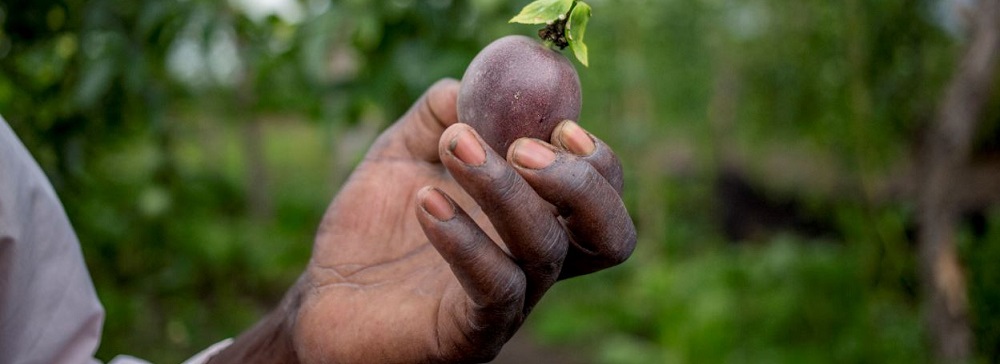
Richard holds out a passion fruit.
Hand in Hand will be there for each and every one of them, first by propagating the crop using cuttings from Richard’s original, then by providing training on its upkeep and care using the Langats’ plot as our ‘demo farm’. Next year, when they’re ready, we’ll help the community form a producer’s group to negotiate with wholesalers, launching their produce into bigger markets and value chains. And we’re not stopping there.
Throughout Kenya, with generous support from the IKEA Foundation, our model is also propagating, reaching thousands of communities one Richard at a time. By the time we’re one, we’ll have helped more than 43,000 smallholder farmers boost their incomes while standing up to climate change with diversified, resilient crops. The money they earn will reverberate far beyond their smallholdings.
“I’ve got a boy in secondary school, a daughter in university studying French, and another studying computers at the Technical University of Mombasa,” says Richard. “With the money I earn, I’m paying the fees.”
Jane puts it more simply. “Now that we grow passion fruit instead of maize, we can buy our daily meals – not grow them. And when the children come home to visit, they can keep some money. I feel very happy, very loved. It’s a special feeling to know I can give them some money.”
And with the even newer
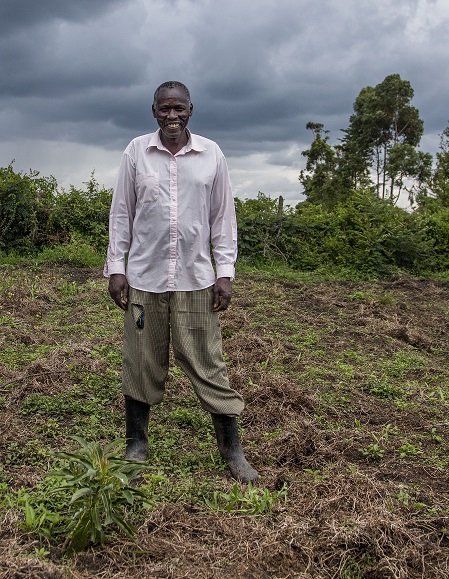
Richard, 54, his avocado plant and his empty field.
Back to the empty field, and Richard’s lone, straggly plant.
“This is hass avocado,” he says. “I got it from Hand in Hand.”
Kenya’s avocado exports have increased eight-fold since the turn of the century. Last year alone, prices doubled. A byword for Western hipsters, the nutrient-rich fruit is growing in popularity domestically, too. And Richard, and his neighbours, are soon to cash in.
Three years from now, this field and the farms surrounding it will support hundreds of fruit-bearing trees, the Langat’s plot again acting as demo farm, with Hand in Hand again providing support. Even if prices stall, each tree will be worth US $100 a year.
“You can see the way that I’m happy. I didn’t think it would be possible, I didn’t believe. I don’t even know if this is reality or a dream, because happiness comes for me if I just have a small-small profit from my crop,” says Richard, crouching down to get closer.
It’s not much to look at yet. But it will be.
By the numbers
KES 7,000 (US $70) loss growing maize during last harvest
KES 15,000 (US $150) per week growing passion fruit
Putting children through school and university
‘This good life makes me feel happiness’: Kipkoech, shop owner
Kipkoech Bernard Cheruiyot was having a hard time supporting his family as a farmer. An unpredictable climate in Kenya’s Bomet County meant frequent droughts often affected his yield, making it hard to earn a profit that would support his wife and three children.
After learning the basics of shopkeeping from Hand in Hand, though, Kipkoech, 31, has found the financial freedom he had long desired — and now has his sights set on becoming a wholesaler.
“Before, when I was only doing farming, I did not see much profits,” Kipkoech said. “When I started this business, I see how much my life has changed.”
Bomet County, Kenya
Competing for success
Poverty in Bomet County is rife: 42.9 percent of households have a combined income of less than US $3.20 a day, according to the Kenya Red Cross Society.
Agriculture is the primary means of employment in Kenya, a trend that’s particularly emphasised in Bomet, where government statistics show there are 58,000 registered farmers, primarily in tea and coffee. That competition, combined with unsteady conditions, can create plenty of volatility in the market — and financial uncertainty among the general population.
Fundamentals for success
Kipkoech, whose wife Winny does not work, was worried his family would go hungry when he learned about Hand in Hand’s Self-Help Groups, generously supported by the IKEA Foundation
Keen to expand his economic horizons, Kipkoech joined the group and learned the fundamentals of entrepreneurship, from how to start a business to the ways to make it successful.
Using the group’s Merry-Go-Round table banking initiative, he secured a loan of KES 10,000 (US $100) in November in order to set up a shop in the Kipsarwet Shopping Center, where he sells sugar, baking flour, soap, tea leaves, cooking oils, rice, maize flour and bread.
Although he acknowledged the early morning hours can be difficult, he believes they are the reason why the shop has been a success.

“I start every morning around 6 a.m.,” Kipkeoch said. “At that time, there are many customers — mostly students who like to buy pens, books, snacks. Waking up early, I can get to know them and help them before my neighbours start to open two hours later.”
Regular customers continue to arrive in the late morning hours, often buying bread, sugar and tea leaves. Kipkoech then closes the shop for the day around 4 p.m., allowing him to relax at home and go running, and it remains closed on the weekends, when he focuses on running his onion farm.
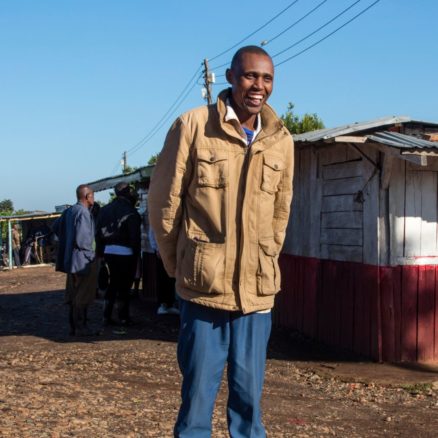
A whole new future
Whereas profit was hard to obtain as a farmer, Kipkoech has realised how much running the shop has changed his life.
“When I started to keep records, I started to see the difference,” he said. “In a day I could make KES 1200 (US $12), or maybe even as much as KES 1500. I know how much I make.”
Not only does he expect to have the original loan repaid by the time it comes due in November, he has been able to change his family’s lives as well. Already, he has built a new three-room house and bought new furniture, and he has been able to afford the fees to move his daughter, 10, into private schooling so that she may better achieve her goal of becoming a doctor.
His ambition doesn’t end there. Within the next three years, Kipkoech would like to expand his business and become a wholesaler. He believes the principles he learned from Hand in Hand have prepared him to apply for a government loan that would help make that happen.
At that point, he believes he’ll be able to make KES 10,000 (US $100) a day — a fortune vastly different from that of a year ago.
“When I look back, a lot has changed,” Kipkoech said. “I have changed my home and improved my children’s education. This good life makes me feel happiness.”
Kipkoech’s results
Learned fundamentals of shopkeeping
Guaranteed a steady income for family
Built new three-room home
Meet Cecily, whose vertical farm has taken flight
Fifteen square meters isn’t just the size of Cecily Wawira’s rented smallholder farm. For years, it was the boundary imposed on her ambitions. But after learning an innovative growing technique called ‘vertical farming’ from a Hand in Hand Self-Help Group – along with the basics of entrepreneurship – things are looking, well, up.
“Many people here are down economically,” says the 44-year-old grandmother from Embu County, Kenya. “If they can be empowered and lifted up the same way we have, they too can become active and do things the way we are doing them now.”
Embu County, Kenya
Making ends meet
Life is changing rapidly in urbanising Embu County, home to more than 500,000 people. According to the Kenya National Bureau of Statistics, 28.2 percent of residents live below the poverty line, which the World Bank classifies as earning less than US $1.90 a day.
For those still working as smallholder farmers, life can especially hard. Problems affecting farming in this arid region range from an unpredictable climate and scarcity of water to, for thousands like Cecily, a simple lack of land.
Maximising growth
For much of her life, Cecily was a casual labourer who struggled to make enough money to purchase even basic necessities.
She rarely made more than KES 250 (US $2.50), which made it difficult for her and her husband to provide not only for themselves, but also for their two children.
“If I wanted to eat an egg or vegetables or meat, I went asking for a loan in the shop,” Cecily said.
Her fortunes changed early last year, when she learned about the Mathayo Women Self-Help Group.
With generous support from the IKEA Foundation, Hand in Hand trainers led regular morning meetings in which the women were taught the fundamentals of running their own business.
“I listened to them and I heard they had good things to say, such as the importance of having savings to improve my life and how I will benefit,” Cecily said.
That rekindled her interest in farming, but because of a lack of land, she had to be creative. With the support of the Self-Help Group, Cecily learned how to set up a vertical farm – a series of outdoor shelves holding bags of soil where vegetables grow – to maximise her limited space.
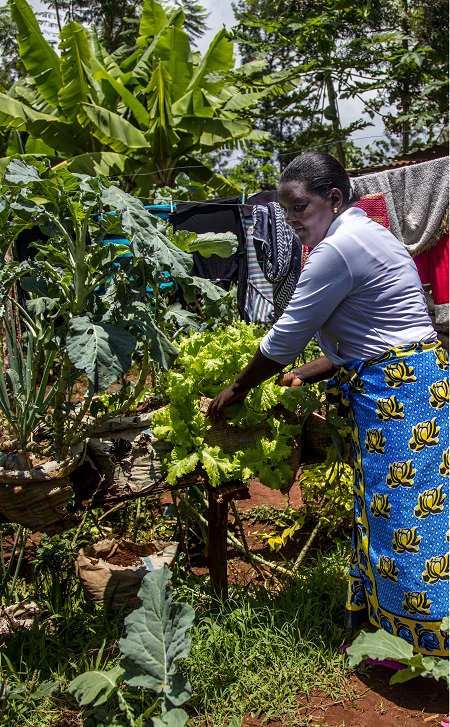
“Because here land is small, I see it’s important to plant that way,” Cecily said. “Now I benefit by eating the vegetables – spinach, kale and amaranth – and there are others I sell.”
Spreading her wings
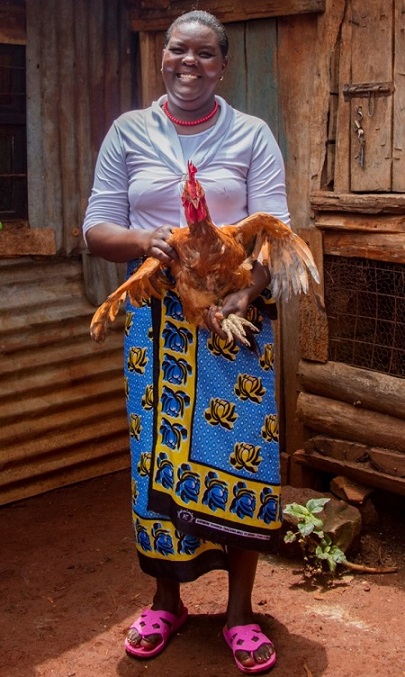
IKEA Foundation projects Embu run by Hand in Hand East Africa.
Cecily’s calculations were correct. She was soon able to sell her vegetables, keeping some of the profit as an income and reinvesting the rest. She then began retailing bananas, which she sold for a weekly profit of KES 2,000 (US $20).
Within time, the profits from the vegetable farm and the bananas helped her dream grow bigger. Now, Cecily raises chickens and sells eggs for KES 25 (US $0.25) each. She even uses the manure as a fertiliser for the soil in which she grows the vegetables.
“The biggest difference is that I am very busy doing a lot of things and I am making good money,” she said.
Each day, Cecily aims to put aside a portion of her profit for her savings. She has been able to help her children, aged 24 and 22 with children of their own, to support their families. She has also noticed her neighbours have set up their own vertical farms.
And, with the money she has earned from her growing business, she and her husband have a new financial goal.
“Eventually I want to build my own house so I can improve my life,” Cecily said.
Cecily’s results
Set up her own farming business
Reinvested profits in order to expand
Set goal to one day own home and land
Meet Wilter, the tailor with a growing market share
Before joining a Hand in Hand Self-Help Group in Bomet County, Kenya, Wilter and her family of three could barely afford breakfast. “We ate leftover ugali [a traditional dish made of maize flour] every morning,” she says. “Now we get fresh eggs and tea.”
The 28-year-old’s tailoring business has doubled in size since she received business training from Hand in Hand with generous support from the IKEA Foundation, and today nets a profit of 8,000 KES (US $80) a month. At the same time, Wilter’s growing trainee workforce has pushed her products into new towns and villages.
Life in Bomet
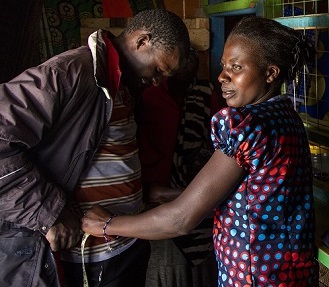
IKEA Foundation projects in Bomet County, Kenya, run by Hand in Hand Eastern Africa.
Opportunities in Bomet, one of the most densely populated areas in western Kenya, are overwhelmingly limited to agriculture. The area is known for its tea and dairy industry, and most women tend to the home and cattle. Sixty percent of the working population sell crops for a living. Five percent hold permanent jobs, almost none of them women.
“Women don’t venture into business because they don’t know they can,” says Wilter. “Because of the culture, women spend a lot of time alone or at home.”
It wasn’t just an upgrade in business skills that put Wilter on the path to success, then, but a change in outlook.
A lesson in market share
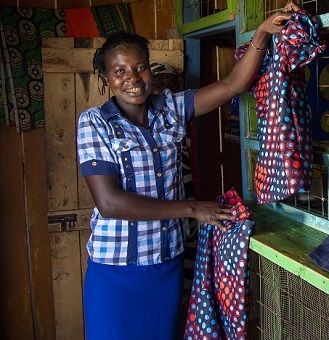
IKEA Foundation projects in Bomet County, Kenya, run by Hand in Hand Eastern Africa.
Wilter got started repairing torn shirts and dresses for friends and family. After getting access to a loan via Hand in Hand, she bought some fabric and started selling her own creations. But it wasn’t until her Hand in Hand trainer taught her about market-building that she landed a contract making uniforms for her 8-year-old daughter’s primary school and things really took off. “Not only do they buy the uniforms, but they also come independently if they need more pieces as well,” she says.
“Before Hand in Hand training, I didn’t have money to do this kind of work. Now I have machines and materials,” she says. But she has no plans to stop there. With her new income, Wilter is focused on increasing her stock and enhancing her business. “My goal is to make it bigger and teach more trainees,” she says.
